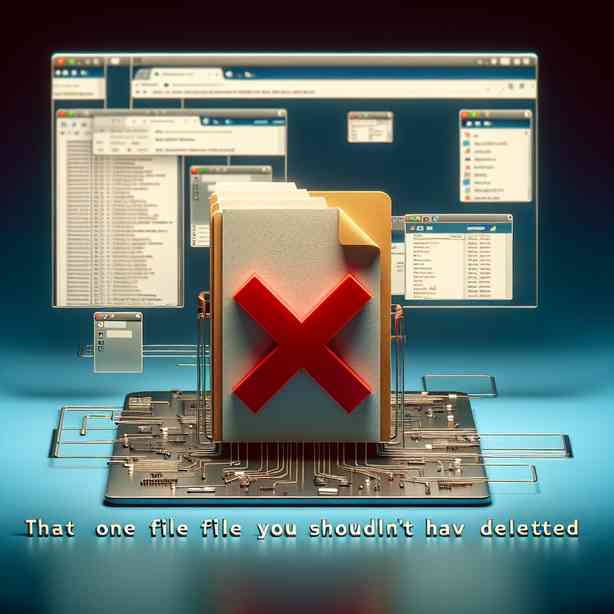
In today’s digital age, data management has become a critical aspect of both personal and professional life. The importance of files and data cannot be overstated, and yet, many of us have experienced the painful moment of realizing that we have deleted a file we shouldn’t have. This experience can feel agonizing, especially if the file in question was a vital component of our work or cherished memories. Understanding the implications of such deletions, along with tips on prevention and recovery, is essential for anyone navigating this digital landscape.
When we think about the files we may accidentally delete, there are numerous possibilities. A work report, a family photo, or maybe a critical presentation can all hold significant value. The repercussions of losing these files can range from inconvenience to considerable setbacks in our projects or cherished memories. Therefore, recognizing the urgent need to safeguard our data becomes not just prudent but essential.
Understanding the processes that lead to inadvertent deletions helps us avoid such mistakes in the future. Accidental deletions often occur due to a combination of lack of attention and the intuitive design of user interfaces. Many systems are designed to facilitate quick access, which occasionally backfires, leading users to delete files without fully realizing it. This highlights the importance of developing a cautious mindset when managing files, as well as implementing strategies to protect vital documents.
One effective strategy is to create a structured file management system. This means organizing files into folders based on specific criteria, such as project names, dates, or categories. By doing so, individuals can locate files more easily, which reduces the likelihood of accidental deletions. In addition, labeling folders clearly and consistently can help create an intuitive layout that simplifies navigation. While this may seem like a time-consuming task, the long-term benefits of organization greatly outweigh the initial investment of time.
Another practical approach is to utilize file versioning and backup solutions. Many operating systems and cloud storage services come equipped with features that automatically save past versions of files. By enabling these features, users can recover previous iterations of a file even after it has been deleted or overwritten. Furthermore, implementing a regular backup routine—whether through external hard drives, cloud services, or even a combination of both—ensures that crucial data remains safe.
In addition to organizational strategies, fostering habitual practices can reduce the risk of loss. For example, it can be beneficial to make it a habit to review items in the trash or recycle bin periodically. Many users may overlook this simple step, assuming deleted files are irretrievable. However, regularly checking the recycle bin can occasionally unveil file remnants that could be useful. It’s a small habit that can save significant time and trouble down the line.
When discussing data loss, it’s also essential to understand the psychological impact it has on individuals. The realization that a critical file has been lost can cause stress and anxiety. This is particularly true if the lost content has emotional or personal significance. It’s vital to acknowledge these feelings and remind ourselves that such occurrences are common. Building a support network among peers can provide both practical solutions and emotional reassurance during such stressful times.
However, if the unfortunate situation of losing a critical file occurs, what are the steps one can take to attempt recovery? The first step is to check the recycle bin or trash folder. Familiarizing oneself with the specific pathways in the system can speed up this retrieval process. If the file is not found there, there are various software solutions available that specialize in file recovery. Many of these tools can scan drives and recover deleted files, depending on how long ago they were removed and the activity on the drive since then.
Importantly, however, when using recovery software, it’s crucial to follow the instructions carefully to avoid further data loss. Avoid writing new data on the drive where the deleted file resided, as doing so can overwrite the space and make recovery increasingly difficult. Taking time to research specific recovery options can be beneficial, as different tools offer varied success rates based on the types of files and the way they were deleted.
Moreover, reinforcing the need for proper education on file management and recovery can empower individuals to take action when faced with potential file loss. Many institutions and workplaces could benefit from workshops or training sessions focused on data management. Helping individuals understand the importance of regular backups, proper organization techniques, and recovery options can cultivate a proactive mentality towards data protection.
In conclusion, the experience of deleting a critical file can be a daunting and stressful one, but with the right strategies and practices in place, we can minimize the chances of such incidents occurring. Establishing an organized file management system, creating regular backups, and fostering awareness about recovery options can be instrumental in protecting our data. Additionally, recognizing the emotional toll that data loss can take is essential, as it allows us to approach the situation with understanding and empathy. By equipping ourselves with the proper tools and knowledge, we can navigate the complexities of digital data management with greater confidence and resilience, ensuring that we’re prepared for whatever challenges may arise in the future.


